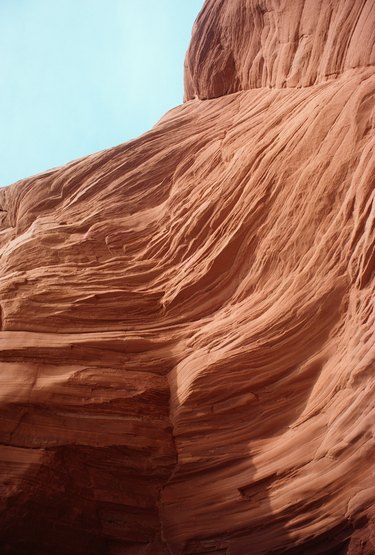
Weathering occurs when the physical and chemical characteristics of rocks found on the earth's surface undergo change. The agents affecting these changes are various components of water, found in the earth's hydrosphere, or gaseous substances from the atmosphere. Exposure to air or water changes the environment in which the rock sample is found. Man-made influences, such as the pollution that causes acid rain or other forms of chemical intrusion, accelerate weathering. Each rock type weathers differently.
Basic Rock Types
Video of the Day
All rocks found on the earth are either igneous, sedimentary or metamorphic, depending upon how they are formed. Liquid rock or magma that cools and crystallizes underground or erupts to the surface as lava and subsequently cools and forms crystals is labeled as igneous. Sedimentary rock forms when particles from other rocks cement and compact under extreme pressure. Metamorphic rock is formed by the forces of heat and/or pressure that alter and harden sedimentary rock.
Video of the Day
Granite
Granite is a light-colored igneous rock formed deeply beneath the earth's surface. The crystals found in granite are coarsely grained and consist mainly of feldspar and quartz. Feldspar gives granite a pink, gray, green or bluish hue, while quartz affects a whitish opaque appearance. Deposits of granite are exposed as the softer rocks above them weather and erode. Granite itself is extremely hard and therefore weathers very slowly.
Sandstone
Sandstone is a sedimentary rock formed due to the breakdown and weathering of other rocks. As its name suggests, sandstone is formed underground from grains of sand that have been cemented and compacted by the pressure of rock formations lying above them. Using a magnifying glass, you can see the individual grains of sand that make up the rock. When sandstone breaks, fractures form around the sand grains.
Differential Weathering
Rocks that contain quartz stand up well to the forces of chemical weathering. Granite is extremely resistant and sandstone a little less so due to the percentage of quartz that each rock type contains. Granite is extremely hard and less affected by the freeze-thaw cycle, the forces of abrasion and the surface exfoliation processes that are all a part of physical weathering. A gravestone made of granite will therefore resist fracturing, cracking and chipping longer than a sandstone marker found in the same location.